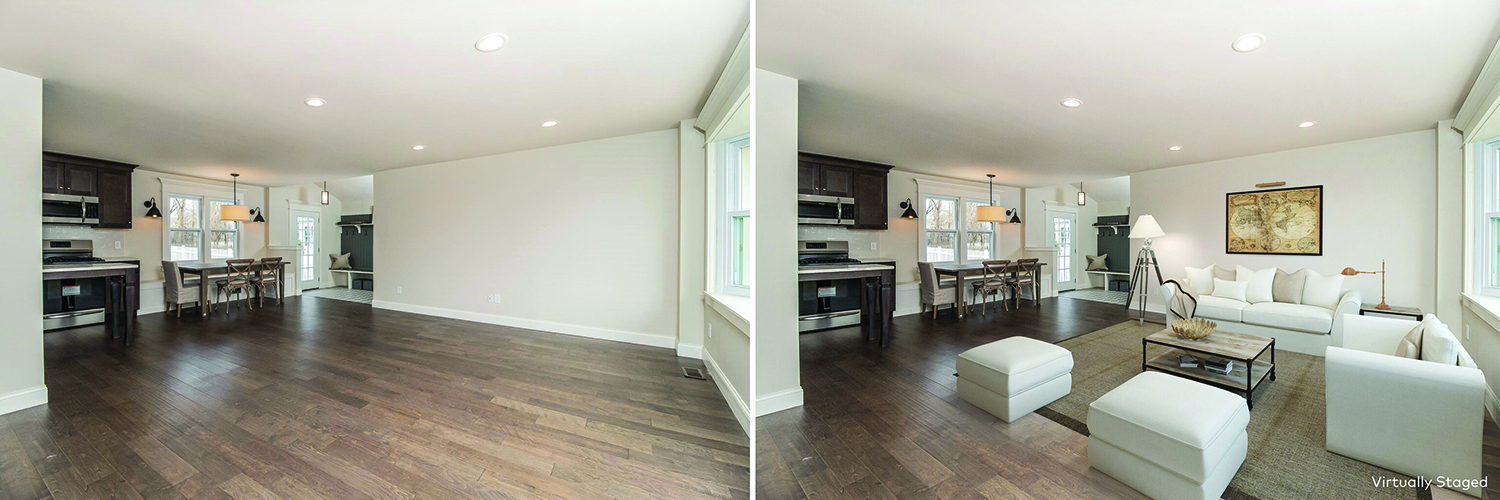Marketing or Misleading?
The home-buying process now starts online, which makes it critical to present your listing in the most appealing way possible. From creative word play in your property description to engaging imagery in your online tour, the intent should be to attract attention to the home, never to misguide offers. Digital manipulation is ubiquitous in online marketing, and recent advances in photo editing technology have created challenges in defining what is presenting a property in a positive light—and what is outright misleading.

“Credit: PlanOmatic
Examples of Ethical Photo Editing
Photo editing can be a budget-friendly solution to physically changing a listing; however, the intended use should be to inspire ideas, not to conceal issues.
One of the most common uses for photo editing in real estate is virtual staging. Staged homes sell 88 percent faster and for 20 percent more money. Physically placing staging furniture in the home isn’t only an inconvenience to the seller, but it’s extremely expensive for the agent. Home stagers charge around $300-$600 for an initial design consultation, and $500-$600 per month per room. That adds up to about $2,000-$2,400 a month for a 2,000-square-foot home. The cost of virtually staging a listing is nominal in comparison. PlanOmatic only charges $99 an image to place the furniture of your choosing in a room digitally.
Professional photo editing can go beyond simple furniture improvements. A couple clicks can inspire a different use of space by turning an office into a bedroom. Editing can remove eyesores like owner-occupied clutter or unsightly holiday decorations. The most popular uses of the technology are “twilight editing,” which creates a moody twilight effect, “blue sky editing,” which turns overcast skies into blue skies, and “green grass editing,” which makes patchy grass appear fuller.
These applications can’t be considered manipulative to buyers because they’re simple cosmetic changes that don’t affect the value of the home.
Examples of Unethical Photo Editing
The power of Photoshop can easily make simple design updates to flooring, fixtures or paint in a home. More advanced users can pull off a full “Property Brothers” remodel if requested. While these orders can have a huge impact on opening the minds of buyers, the use of heavy alterations should be clearly disclosed to protect the consumer.
Competition in the market has recently increased the number of sight-unseen offers. Redfin reported that somewhere between 20 and 35 percent of recent homebuyers said they made offers on houses they had never set foot inside. These offers would be understandably inflated if the images the buyer saw online had been heavily digitally altered—and could drastically change the course of the deal to favor the seller.
How to Ethically Use Digitally-Enhanced Photos in Your Marketing
Without laws regulating the use, we remain in the Wild West of the digital enhancement era. The onus lies with real estate professionals to act in the interest of their clients.
A quick survey can help to guide your choices when using altered photos in your marketing materials. Ask yourself these questions:
- Is the edited item a permanent fixture?
- Would the changes made in the image affect the value of the home?
- Have you disclosed the image alterations?
PlanOmatic provides virtual staging services and custom Photoshop work that’s clearly and deliberately disclosed. As a real estate marketing company, we protect consumers by watermarking virtually staged and custom edited assets.
“Only through responsible use of emerging technologies will innovation continue to progress in real estate,” says Kori Covrigaru, CEO of PlanOmatic.
 Lauren Maloney is the marketing manager at PlanOmatic. For more information, please visit www.planomatic.com.
Lauren Maloney is the marketing manager at PlanOmatic. For more information, please visit www.planomatic.com.











